Sexy CJ
The weather wasn't very obliging, but we pushed ahead regardless. As usual, Chek Jawa seldom disappoints, even in a drizzle.
The busy butterflyfish is always a delight to encounter. While the delicate flowery sea pen is usually only seen at night.

We always get excited by nudibranchs. We DID see a rather large one (about 15cm long), but it wasn't very pretty. I still haven't found out its name although we often see it on the Northern shores. Of course the neat biscuit star is another favourite, and more commonly seen at night. The crabs were a little challenging. I first saw the purple climbing crab on the pillar, but only later noticed the yellow swimming crab right under it! And the wonderfully camouflaged velcro crab was only spotted when it started moving. This one had a very long piece of red seaweed on its head! And blue and pink sponges all over it. Can you see its legs?
The crabs were a little challenging. I first saw the purple climbing crab on the pillar, but only later noticed the yellow swimming crab right under it! And the wonderfully camouflaged velcro crab was only spotted when it started moving. This one had a very long piece of red seaweed on its head! And blue and pink sponges all over it. Can you see its legs?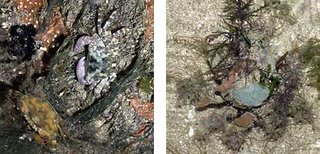
There are sea fans on Chek Jawa! The water was clear, but it was drizzling and the wind was blowing up the water. These delicate and colourful things are not plants and are actually colonies of tiny animals. I've also seen them on Changi.
A closer look and you can see the tiny white polyps that emerge from the common skeleton.
Another wonderful surprise: feather stars! This is the first time I've seen them on Chek Jawa. Usually, we only see them on Beting Bronok.
There were two of them. One blackish and the other a lovely shade of light blue. These animals are in the same group as sea stars but have a lot more arms which are feathery and very flexible.
The sponges, as usual, were crowded with synaptid sea cucumbers, shrimps and who knows what else. The tiny shrimp in this photo is transparent, and you only first see its tiny eyeballs.
I stumbled on this very handsome orange-and-black Mama noble volute. She was laying a very VERY large egg capsule (the white crystal-like column to the left under her foot). She looks like she's been at it for some time.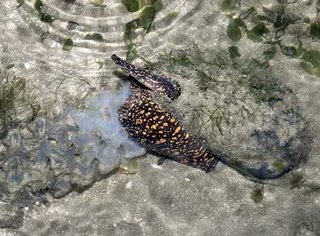
Ron also saw a ruby-red nudibranch laying a ribbon of eggs. Hopefully he can upload the photo soon. I wasn't there to catch it.
The whole shore was teeming with swimming sea anemones. These rather boring looking sea anemones are like a ball of tentacles and actually swim about. Other sea anemones generally remain stuck to one place, with their foot buried in the sand or a hole in some coral rubble.
There was just too many of these swimming sea anemones...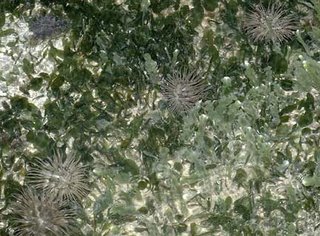
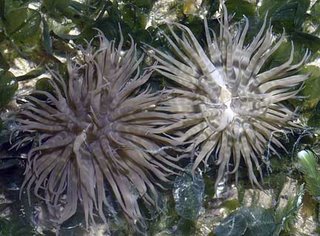
They were also very close to one another. What's going on? Perhaps it's that time of the month when these sea anemones make baby anemones? There's so much more we have yet to learn about our shores.
A very impressive lightning show started to display over us, and the drizzle became heavier. Adelle wisely called off the tour. Just as I was dragging my feet back to the shore, I came across a very hairy sea hare. These sea hares are seasonal and usually only seen once a year for a week or so. I quickly snapped a shot.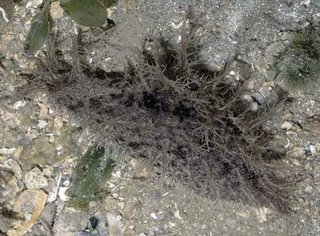
But what's happening here? The sea hare was joining another bunch of sea hares! Haha! Finally, perhaps this is the mating chain of sea hares that I've been trying to observe all this while?! 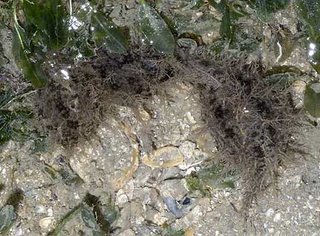
Sea hares are hermaphrodites. Each sea hare has BOTH 'her' and a 'him' parts in one body. In some, the 'her' part is at the backside on the upperside of the body, while the 'him' part is near the head on the underside of the body. Thus to mate, one sea hare will go behind another, place its head on the other's backside and insert the 'him' part into the 'her' part. While it is doing this, another sea hare might be doing the same to its backside, and so on in a chain.
Amazing!
Alas, we couldn't stay to watch the action as it started to seriously thunder and light up and rain. We reluctantly called it a day even though the sun hadn't risen yet.
I'm sure the others saw exciting stuff too and will share on the blog.
Chek Jawa is very sexy and very much alive!

0 Comments:
Post a Comment
<< Home